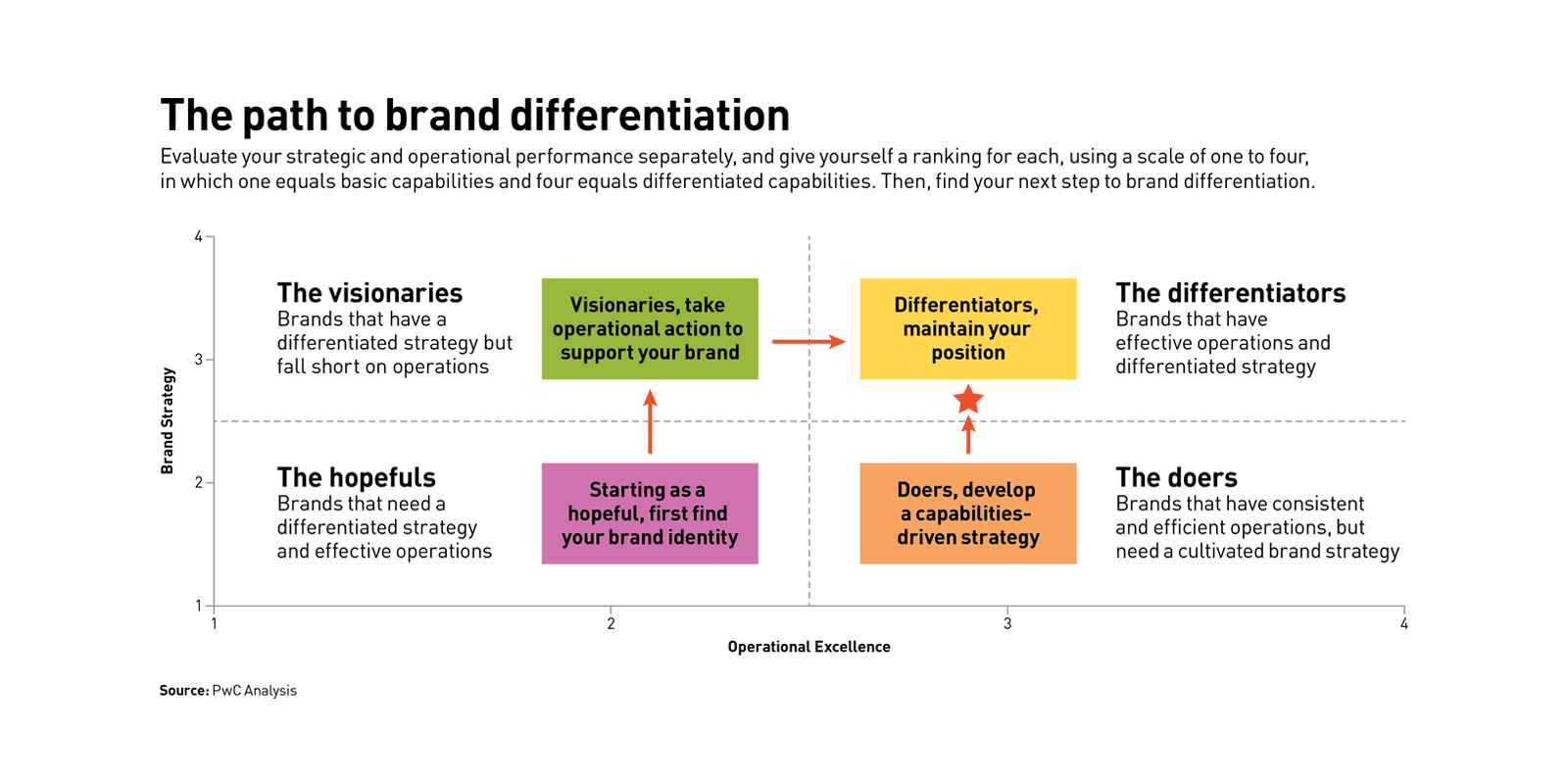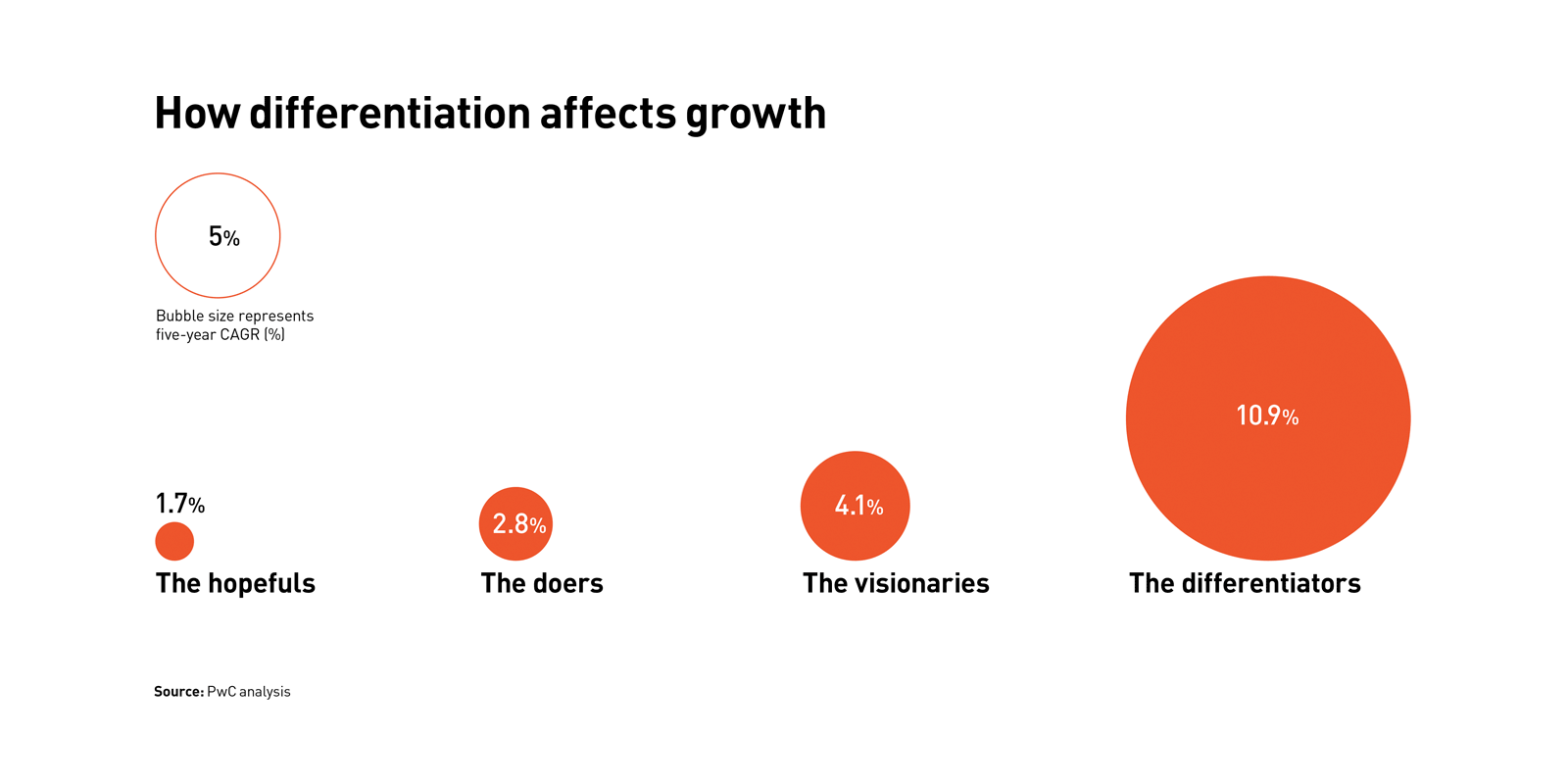How to stand out in a crowded marketplace
To differentiate your brand, let a customer focus guide your strategy and operations.
A version of this article appeared in the Winter 2019 issue of strategy+business.
Competition for brand recognition has never been more fierce. Digital-native newcomers are using tech-savvy, direct-to-consumer approaches to enjoy unprecedented ease of entry. They’re weaving compelling, socially conscious brand stories on social media. And traditional retailers are struggling to differentiate themselves not only from the digital entrants but from their peers, in a landscape oversaturated with stores.
An inability to connect with customers is a big part of the problem for companies that find themselves lost in the undifferentiated middle. In a PwC consumer survey (pdf), 73 percent of respondents said customer experience was an important determinant in their purchasing decisions. In fact, the survey revealed that consumers are willing to pay as much as a 16 percent price premium for a superior experience, and they are more likely to stay loyal to the brand that offers it. Another global consumer survey conducted by PwC suggested that companies should go so far as to develop a company success metric based on experience. But even companies that realize this and center their strategy on consumers can’t set it and forget it. They must be able to adapt as people’s tastes and priorities change.
To implement a successful customer-centric brand strategy, companies need to have a foundation of operational excellence. They should be exceptional on practical points, such as product offering or omnichannel experience, so they have a basis from which they can reinvigorate and maintain customer engagement.
Transforming your strategy and operations in order to differentiate your brand might seem like an overwhelming endeavor, but by taking it one step at a time and letting a customer focus drive your efforts, you’ll avoid getting caught in the undifferentiated middle.
A framework for success
The first step to becoming more differentiated is to take an honest look at your current strategic and operational performance. Your company probably falls into one of four groups:
- Differentiators have both a differentiated brand strategy and effective operations.
- Visionaries have a differentiated strategy but fall short on operations.
- Doers have effective operations but are in need of a cultivated strategy.
- Hopefuls need both a differentiated strategy and effective operations.
To find out which group your brand is in, evaluate your strategic and operational performance separately, and give yourself a ranking for each, using a scale of one to four, in which one equals basic capabilities and four equals differentiated capabilities. To come up with your rankings, assess your company’s effectiveness in four components of brand strategy: identity, value, perception, and awareness. Also assess it in six components of operations: product offering, strategic pricing, digital engagement, loyalty programs, omnichannel experience, and supply chain.
To be considered differentiated, you should rank at a three or four in each of the brand strategy components and at least two of the six operational components.
Becoming a differentiator
The path to differentiation (and to thriving as a differentiator) depends on whether your company is currently a hopeful, a doer, a visionary, or a differentiator (see “The path to brand differentiation”).
• Hopefuls: The most important step is to build a strong brand strategy. This starts with defining the right brand identity. Understand what your brand represents, what value it brings to the customer, and how that value sets it apart from the competition.
• Doers: Rather than starting from square one, you’d benefit from a capabilities-driven strategy. Identify what your competitive advantage is and build your strategy around that.
• Visionaries: Your focus should be on building operational capabilities so you can take action on your strategy. Be mindful of how to allocate resources in a way that aligns well with your brand strategy. For example, if your brand focuses on innovation, then product development and R&D would take precedence over other investments.
• Differentiators: The key is to grow strategically — through innovation, strategic alliances, and more — to stay on top.
Evidence that differentiation matters
PwC used this framework to assess the performance of 20 well-known consumer brands and discovered that the differentiators exhibited a higher rate of growth than those in other groups. The median five-year compound annual growth rate (CAGR) for differentiators exceeded that of all other groups, at 10.9 percent, and hopefuls were lowest, at 1.7 percent.
Interestingly, companies that ranked high in brand strategy achieved stronger growth than those that didn’t, regardless of how well they executed operationally. By adding operational excellence in support of a strong brand strategy, companies clearly supercharged their performance (see “How differentiation affects growth”).
How to build strategy, then operations
For hopefuls and doers to become visionaries and eventually differentiators, they have to put customers at the center of their approach to the four important brand strategy components — identity, value, perception, and awareness — and then build operational capabilities on top of that strategy. Here’s how.
Focus on what you do best for your customers. In 2013, plus-sized women’s apparel and lifestyle brand Ashley Stewart was in disarray and facing liquidation. But James Rhee, a private equity investor, saw that the company gave customers a unique and needed sense of community, treating them with respect and dignity, so he bought it. Today, Ashley Stewart is flourishing, with 89 stores in 22 states and a thriving online presence. Rhee’s pathway to differentiation involved fostering the authentic customer interactions that defined his brand’s identity and value and using methods such as targeted celebrity endorsements, college empowerment tours, and a brand ambassador contest to affect brand perception and awareness. The company then supported those strategies with operational elements, such as an omnichannel presence (with both online and in-store experiences) and digital engagement (through savvy social media use). Ashley Stewart is now a successful brand with a sought-after emotional connection with its customers.
Beauty brand Sephora is another example. The company has transformed the cosmetics industry by serving up a cosmetic playground that allows people to experiment with products. Customers are encouraged to stay and play as long as they’d like. And that experience has now been translated to the digital realm, too, by the Sephora app, which uses augmented reality to allow customers to try on products by uploading a photograph of themselves. Sephora’s approach has been so well received that the company announced in March 2019 that 35 new stores would open before the end of the year.
Realize that value involves more than just price. Eyewear company Warby Parker’s clear and distinctive mission appeals to customers’ social values and is augmented by its operational excellence. The company has captured a hefty share of the U.S. online market both by selling direct to the consumer — thus minimizing supply chain costs and passing those savings along to shoppers — and by giving back. For every pair of glasses purchased, Warby Parker donates a pair. The company has already given more than 5 million pairs of eyeglasses to needy recipients across 50 countries. Millennials, known for seeking out (pdf) authentic, socially conscious brands, have connected with the company’s vision. This is an example of impact retailing, in which values other than price are intrinsic to a brand’s identity.
Kotn offers another such example. The company, based in Canada, recently opened its first U.S. store in New York. Kotn sells basic cotton apparel at affordable prices, sourced directly from Egyptian farmers who are subsidized by the company. The company has opened schools near the farms, too, and has a goal to fund 50 schools by 2025.
Make sure you know who your customers are. Vineyard Vines, an apparel brand aiming for a feeling of exclusivity without being out of reach for the average customer, understands that genuine, relevant, personalized communications are critical to how the brand is perceived and valued. Built on top of that strategic principle are operational elements, such as robust analytics, which uncover actionable trends in customer behavior, and integrated online customer and product data, which allows for one-to-one messages.
The company targets customers according to their specific interactions with certain products, using consolidated data that reveals price sensitivity. By adjusting its offerings, Vineyard Vines can tailor its digital promotions to individual shoppers. In an era in which people expect highly personalized offers, the company delivers. Loyal customers have come to expect that Vineyard Vines will treat them with respect, providing an optimal experience no matter the channel or touch point.
Get the word out. Today’s consumers want immediate information and inspiration, and they go to social media to find it. Understanding this strategically allows a company to build out operational components, such as digital engagement, that will help execute the strategy. Connected stories and other engaging, authentic content, a highly visible presence via hashtags and other social labels, and a constant focus on the voice of the consumer can be effective tools for enhancing emotional engagement online with customers.
Even companies that center their strategy on consumers can’t set it and forget it. They must be able to adapt as people’s tastes and priorities change.
For example, online home goods retailer Wayfair relied heavily on its extensive social influence early on. In a hypercompetitive e-commerce market, the company’s use of social tools strengthened its overall user acquisition and customer stickiness. Meanwhile, the company continually evolved its supply chain to emphasize speed and convenience. That agility ensures high levels of customer satisfaction and overall growth. Recently, the company furnished and decorated an entire 2,400-square-foot penthouse apartment in New York City. Influencers for a variety of products have used it for photo shoots, thus providing Wayfair with additional social reach. Wayfair has also opened pop-up stores and recently announced its first long-term physical location to drive brand awareness, strengthening its omnichannel presence.
Don’t try to do it all, operationally
Operational excellence doesn’t require differentiation in all six components (product offering, strategic pricing, digital engagement, loyalty programs, omnichannel experience, and supply chain). In fact, given cost and resource constraints, the most successful companies target just a few specific areas. PwC’s assessment of 20 brands found that for a brand to be considered operationally differentiated, it needed to excel in at least two of the six components. Below are some examples of companies that have focused their operational efforts in order to enhance brand strategy and overall differentiation.
• Product offering: Adidas has enjoyed consistently strong growth, setting record-high sales and margins in 2018. As part of its acceleration plan, the company chose to focus its portfolio. This is a differentiated approach, because retailers often do the opposite, expanding into other product categories to sustain growth. But when done poorly, expansion can dilute the brand identity and confuse core customers while failing to attract new ones.
• Strategic pricing: Clothing retailer Everlane is positioned as an ethical value player in the premium apparel market. The company’s pricing strategy reflects its commitment to prioritizing fair wages and trade practices over cheap labor and discount products.
• Digital engagement: L’Oréal has bolstered customer experience by encouraging people to experiment online with their products. Shoppers can upload a photo of themselves through Tencent’s WeChat social media app and then use augmented reality to try on makeup and take before and after photos.
• Omnichannel experience: Today’s always-on consumer is also always demanding. In response, successful brands integrate offerings across multiple channels. Customers may research a product online, then buy in a store. Or vice versa. Either way, a seamless experience is essential to ongoing customer engagement. Nordstrom’s well-regarded customer service infrastructure supports more than 60 combinations in which merchandise may be ordered, fulfilled, and delivered, including “buy online, pick up in store” and “reserve online, try on in store.” Online returns in stores are streamlined for convenience.
• Loyalty programs: As consumers become ever more inundated with an array of choices, loyalty programs continue to grow in importance as an essential tool in the brand arsenal. L’Oréal’s loyalty program presents members with redeemable points for purchases and the option to make a philanthropic reinvestment of their rewards through the company’s “Worth It Rewards” program. Successful loyalty programs offer either highly exclusive or original rewards.
• Supply chain: A well-functioning supply chain is crucial to supporting the brand promise across the value chain — from product design, to production, to order fulfillment, to delivery — with the speed, convenience, and value that customers demand. H&M’s tech investments in global design, production, and inventory management have yielded greater supply chain efficiency, allowing for trendy fast-fashion offerings with rapid turnarounds.
Keep evolving
Complacency is not an option in today’s environment. Not only do retailers confront continual market disruption, but they also face changing macroeconomic conditions, mercurial consumer preferences, and unrelenting competition. Brands that already have a differentiated strategy must stay vigilant. They should use the following tactics to remain relevant.
• Embrace disruption: Digital disruption from new entrants continues to blindside traditional brands, even differentiators. To maintain a leading position, differentiators must have an appetite for innovation and reinvention. By fostering a test-and-learn culture, market leaders encourage teams to fail fast, learn from their findings, and adapt quickly to further improve the brand and develop new products and services.
• Capture growth opportunities: Once differentiators reach the top, they face ongoing competitive pressure to continue being market leaders while also continuing to grow. Acquisition targets can come into play if they leverage or enhance your existing capabilities. Acquiring a startup, for example, provides a traditional company with the opportunity to reach new customers, penetrate different markets, and use the startup’s know-how to stay differentiated. Conversely, a startup would benefit from a traditional company’s physical infrastructure and scale.
• Know your competition: Differentiators should scan the marketplace to identify emerging direct, indirect, and adjacent competitors. And in addition to continuing to differentiate independently, companies can pursue strategic alliances to remain competitive. In fact, a PwC analysis found that more than 25 percent of CEOs lawfully collaborate with competitors.
Winning the brand challenge
The challenge of being caught in the middle is not likely to fade away. If anything, it will become more pronounced. But with a plan centered on first defining a customer-centric strategy, then bolstering operations, and then continually checking and protecting your reinvigorated brand identity, you’ll be on the path to lasting differentiation.
Author profile:
- Isaac Krakovsky has more than 25 years of experience in the retail, consumer, and private equity industries. Based in New York, he is a principal with PwC US in the consumer markets deals practice.
- PwC US manager Shirley Chen and PwC US associate Michael Amicucci also contributed to this article.





